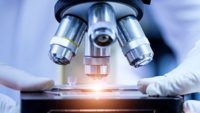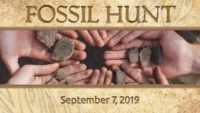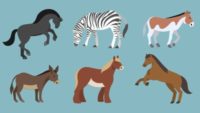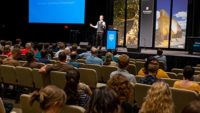Unique structures in rare bacteria suggest the amazing process of photosynthesis is much “older” than evolutionists assumed. Photosynthesis is the process of turning sunlight, water and carbon dioxide into sugar and oxygen. There are two types. The first is anoxygenic photosynthesis that uses molecules other than water to drive the process and doesn’t produce oxygen as a byproduct. The second is More… …read more Source: icr.org
By Ken Ham What do blood cells in a fossilized insect, Noah’s sons, dinosaur soft tissue, the Grand Canyon, and stars all have in common? They are topics of AiG research …read more Source: AIG Daily
By Ann Gauger On this episode of ID the Future from the vault, Ann Gauger discusses physiological, anatomical, cultural and behavioral differences between humans and chimpanzees. How long would it take to acquire needed mutations by Darwinian mechanisms? Much, much longer than the available timeframe, says Dr. Gauger. Your browser does not support playing Audio, please upgrade your browser or find our podcast on podOmatic Download Episode …read more Source: id the future
We present reasons why Mercury and Venus are young, not billions of years old, as per the BBC-TV program The Planets. …read more Source: creation.com
By Sarah Chaffee On this episode of ID the Future from the vault, Ray Bohlin interviews Jonathan Wells about the interaction of evolutionary theory and medicine. Has Darwinism furthered healthcare? What about our understanding of antibiotic resistance? And might learning about evolution become a requirement for medical students? Your browser does not support playing Audio, please upgrade your browser or find our podcast on podOmatic Download Episode …read more Source: id the future
You have been designed with many trillions of cells. Within the nucleus of each cell (except for red blood cells) is the “molecule of life” called DNA. It’s organized into chromosomes (humans have 46) upon which many thousands of genes are found. Genes are hereditary units, comprised of nucleotide bases called T, G, C, and A. Each cell undergoes complex metabolic processes, or metabolism. Because we live in a fallen world,… More… …read more Source: icr.org
By Ken Ham In less than a month, eager fossil hunters will gather at beautiful Caesar Creek Lake in Warren County, Ohio, for a day of learning, fun, and hands-on adventure. And it’s not too late for you to join them! It’s just 75 minutes away from the Creation Museum. On September 7, 2019, AiG geologist Dr. Andrew Snelling and AiG paleontologist Dr. Gabriela Haynes will be leading this adventure, as explorers search for fossils at one of the most popular fossil-hunting sites in our region. You never know what you might find! Previous groups have uncovered corals, shells, various [More]
Could extrasolar planet GJ 357 d, orbiting a nearby red dwarf star, support liquid water or life? More evolutionary hype. …read more Source: creation.com
By Harry F. Sanders, III A recent article from Cell discusses the roundworm and its ability to transmit a learned trait from parent to offspring through four generations. …read more Source: AIG Daily
By Marcos Eberlin On this episode of ID the Future, distinguished Brazilian organic chemist Marcos Eberlin talks about chemical evolution and the origin of life, pivoting off of comments by Rice University synthetic organic chemist James Tour in Science Uprising Episode 5, and off of Eberlin’s own Nobel laureate-endorsed book Foresight: How the Chemistry of Life Reveals Planning and Purpose. The idea of an unguided origin of the first life has been “sold to us,” he says, but its assumptions are “insane … many, many times impossible.” He illustrates from three essential cell features: the cell membrane, protein folding, and [More]
By Heidi St. John “The Busy Mom” sits down with the publisher of Answers magazine to share her advice for talking to kids about sex. …read more Source: AIG Daily
By Ken Ham In just a few months, we will begin a major upgrade of our popular Stargazer Planetarium here at the Creation Museum. For over twelve years, the planetarium has been a highlight for so many of our guests, and we’re excited to make it even better than ever so it can be more thoroughly enjoyed by millions more. The upgrade includes: A new laser projector — This gives us an 831% increase in brightness and a 355% increase in resolution. You will be awed by what you see. Upgraded Digistar software and components — Our current servers and [More]
By Ken Ham We live in an increasingly secular culture where many are unresponsive or even hostile to God’s Word and the gospel message. How can we, as believers, have the courage to continue sharing the gospel with others, no matter the reactions we meet? We are just called to speak and share truth and give reasons for what we believe. Well, it’s important to understand that it’s not our job to convert anyone! We are just called to speak and share truth and give reasons for what we believe. I often compare it to Jesus raising Lazarus from the [More]
By Ken Ham A recent poll in the United Kingdom revealed that 89%—nearly 9 in 10—of young people, aged 16 to 29, “believe that their lives have no meaning or purpose.” This saddening statistic is explained with a corresponding statistic shared in the same article—only 1% of this age group identifies as belonging to the Church of England, the largest denomination in the UK, meaning that very few young people in the UK hold to any semblance of Christianity (half of UK residents are atheists). This is being reflected in decreasing church attendance. In England, such attendance is …read more [More]
Sneak peek of latest Creation magazine. The co-authors of Contested Bones talk with Creation magazine …read more Source: creation.com
By Dr. Nathaniel T. Jeanson One of the keys to the origin of species is a concept that few have heard of—genetic drift—the simple application of statistics to basic genetics. …read more Source: AIG Daily
By Ken Ham Tom Meyer, “The Bible Memory Man” as he was first dubbed by us at AiG a few years ago, of At one of our AiG staff meetings this year, Tom recited the entire Book of James from memory. Above is a photo of his presentation in front of the staff and volunteers. We carry Tom’s “The Memorization Study Bible,” a practical book that features techniques to help you memorize Scripture. Tom would be the first to tell you that he does not have the natural gift of memorization. So he has developed techniques to assist him …read [More]
How do we communicate the truth over social media? …read more Source: creation.com
By Marcos Eberlin On this episode of ID the Future, internationally distinguished scientist Marcos Eberlin, author of the new book Foresight: How the Chemistry of Life Reveals Planning and Purpose, talks about evolution’s “water gate” problem. There’s no conspiracy here, just life’s astonishing answer for admitting water into cells through “gates” while keeping lethal acidifying proteins out. There’s also a chicken-egg problem involving proteins and molecular chaperones. That and more, Eberlin argues, add up to the conclusion that life required foresight. Your browser does not support playing Audio, please upgrade your browser or find our podcast on podOmatic Download Episode [More]
By Ken Ham In the United States alone about a quarter to half a million people have American Sign Language as their natural language. As a part of the Deaf community, these individuals have a language and culture unique to them. Every year, we offer Deaf Days at both the Ark Encounter and the Creation Museum in Northern Kentucky as an outreach to this community. And, for the first time, this outreach has been expanded from Deaf Days to Deaf Answers, a special conference in ASL, at the Ark Encounter November 8–10, 2019. During this special apologetics/biblical authority conference …read [More]
How moving around the world helped set the groundwork for a young scientist to become part of a dynamic ministry. …read more Source: creation.com
By Ken Ham The LGBT media monitoring organization, GLAAD, releases the results of their “Accelerating Acceptance Survey” every year, since 2016. The results from the 2018 survey were somewhat surprising—there has been a significant drop in LGBT “allies” according to the survey results, particularly among 18–34-year-olds. Why the drop, especially among the demographic that is supposed to be the most LGBT-accepting generation? GLAAD defines an “ally” as someone who says they are “very” or “somewhat” comfortable with seven scenarios they are presented with. Those scenarios include situations such as “finding out their child had a …read more Source: Ken Ham [More]
By Sarah Chaffee Today’s episode of ID the Future brings you a conversation between Discovery Institute senior fellow Jonathan Witt and radio host Jerry Newcombe, originally presented on Newcombe’s nationally syndicated radio show. The two begin by discussing the Discovery Institute’s Science Uprising video series, which Jonathan helped create. From there they go on to talk about philosophical materialism, free will, morality, and what it means to be human. They touch on the Darwinian opposition, and on the rising threat of censorship. Your browser does not support playing Audio, please upgrade your browser or find our podcast on podOmatic <a [More]
The LCMS’s recent resolution on creation is an encouraging example for others. …read more Source: creation.com
By Sarah Chaffee On this episode of ID the Future, Cambridge-trained bestselling author Stephen Meyer discusses some good questions posed to him at a recent science seminar he lectured at in Seattle. Then he unveils details of his forthcoming book The Return of the God Hypothesis: Compelling Scientific Evidence for the Existence of God–evidence pointing not just toward any designer, but toward a transcendent, rational, intelligent being such as the one Jews and Christians worship. Your browser does not support playing Audio, please upgrade your browser or find our podcast on podOmatic Download Episode …read more Source: id the future [More]
A recent Public Broadcasting Service (PBS) report highlighted creatures’ designed innate capacity to self-adjust to incredibly challenging exposures.1 The article, by Stuart Thompson who is a senior lecturer in plant biochemistry at the University of Westminster, describes plants thriving around the former Chernobyl nuclear reactor in spite of high doses of radiation. Though he claims the radiation-resistant mechanisms in p… More… …read more Source: icr.org
By Warren H. Johns The central issue among creationists is whether any purported fossil forests are truly autochthonous. …read more Source: AIG Daily






































